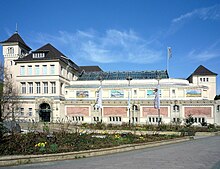| Berlin Aquarium | |
|---|---|
 Berlin Aquarium | |
 | |
| 52°30′21″N 13°20′26″E / 52.50583°N 13.34056°E | |
| Date opened | 1913[1] |
| Location | Berlin, Germany |
| No. of animals | 9,000+[2] |
| No. of species | 800[2] |
| Website | www |

The Aquarium Berlin in Berlin is one of Germany's largest aquariums. The aquarium was built in 1913 as part of the Berlin Zoological Garden complex.[1] Since its opening, the Zoo-Aquarium has been ranked among the public aquariums with the world's greatest biodiversity.
Exhibits[edit]
Over 9,000 animals are presented on three storeys.[2] It contains jellyfish, tropical and native fishes, crocodilians (caimans and gharial), and a broad variety of insects. In addition to its 250 tanks for fish,[1] the aquarium houses a wide variety of amphibians and reptiles, including tuataras.[2]
The shark tank presents the blacktip reef shark and other species.[2]
With a total capacity of 25,000 litres (6,600 US gal), twelve basins present different sections through the world of corals. The largest of these basins is the 11-cubic-metre (2,900 US gal) Great Coral Basin with its reproduction lagoon.
References[edit]
- ^ a b c "A brief introduction to Berlin Zoo". berlin-life.com. Berlin Life. Retrieved 5 September 2010.
- ^ a b c d e Aquarium Berlin: Zoo-Aquarium Berlin. Archived 2013-01-03 at the Wayback Machine Retrieved 30 December 2012.
External links[edit]
 Media related to Berlin Aquarium at Wikimedia Commons
Media related to Berlin Aquarium at Wikimedia Commons- Official website
- Tourism in Berlin

Well, that’s interesting to know that Psilotum nudum are known as whisk ferns. Psilotum nudum is the commoner species of the two. While the P. flaccidum is a rare species and is found in the tropical islands. Both the species are usually epiphytic in habit and grow upon tree ferns. These species may also be terrestrial and grow in humus or in the crevices of the rocks.
View the detailed Guide of Psilotum nudum: Detailed Study Of Psilotum Nudum (Whisk Fern), Classification, Anatomy, Reproduction